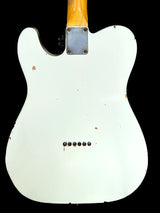Where does the idea come from?

According to this great article, the history of guitar relicing started with two amazing builders at Fender - Jay W. Black (master builder at Fender and later Linhof guitars) and Vince Cunetto (Fender co-operative, his aging treatment is considered legendary among guitar collectors). The two started relic jobs as a side-project for Fender Custom Shop guitars in early 1990s. The idea of look-like-old guitars quickly became a hit and Fender Custom shop guitar department was fully involved in producing relic guitars. The era of cooperation between Cunetto and Fender ended in 1998, and guitars from that period have a really high value in the market. But it was just the beginning.
BTW, this great article from Guitar.com is also well worth reading!
It's not only about the looks
As a guitarists, we tend to be sentimental about the good old days of guitars. Sometimes we refer to 1950s and 1960s as the golden era of guitar builders. And although the production quality was really inconsistent, some of the instruments didn't survive the trial of time, every guitarist on the planet would love to have a real 1957 Stratocaster or a 1954 Gibson Les Paul. Prices of such guitars are growing exponentially with time (they are real collector pieces and a good investment if you can afford it).

The idea of relicing guitars went far beyond the looks of the instrument. Currently we expect relied guitar not only to look, but more importantly to feel like a vintage, well played-in instrument. A perfect aged guitar would be indistinguishable from a real thing from 50s or 60s and guitar players still look for such a holy-grail in currently produced guitars. When talking about real-vintage feel many names would be mentioned: Danocaster, Linhof, Nacho Guitars, K-Line, and more. They would have a thin nitro lacquer, some sings of wear such as dings and scratches, spots where the paint has been worn out from the constant contact with a hand. But most importantly - it will have a distinct sweetnes in the midrage we love the real vintage guitars for.
The levels of aging
As time went byt, the makers took the art of relicing to the extremes. Some, like Gibson Murphy Lab series will aim at tasty, subtle relic job that will emulate an instrument with 60-70 years of history but still beign well taken care of. On the other hand you can find very heavy relics, with large spots of wood cutting through the paint. Some of the extreme relics are not even realistic - it's literally impossible to make a guitar look like this while playing it.

Let's analyze different levels of relic treatment using Fender names as reference:
- NOS (New Old Stock) - zero relic job, like new. See this James Tyler 1987 Studio Elite 35th Anniversary for an example
- Closet Classic - a guitar that has been produced and closed in the case for 50 years. With time the paint has developed some gentle check and the hardware may be dull but nothing serious. An example would be this Fender Custom Shop Telecaster.
- Journeyman Relic - the guitar was taken care of and travelling with the musician for years. It has some slight wear to it - gentle dings and scratches, the back of the neck developed some wear. Overall, the guitar was used but not abused. An example could be this Postmodern Fender Custom Shop Stratocaster
- Relic - more serious use was applied to the guitar. It was played and used on tour much more than Journeyman, also, not treated that carefully. Like a favourite tool - it got more damaged with time. A nice example would be this Haar Trad S
- Heavy relic - the guitar was really abused. You either played it 12 hours a day and left it everywhere in the bar after the gig, or you gave it to Steve Ray Vaughan for a year. Not realistic for most of, still looks cool as hell. Here's an example of Fender Custom Shop 52 Telecaster in Heavy Relic version
- Super heavy relic - rather unrealistic, all beaten up piece of gear. It's very polarising - you either love or hate it. Half of the body stripped off of the paint, serious damage to the surface of the wood, it's not for faint hearted. One we had in our store was this 1963 Fender Custom Shop Stratocaster NAMM Limited.
That's a brief look at relic guitars. What is your favourite relic job?




